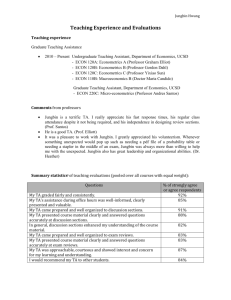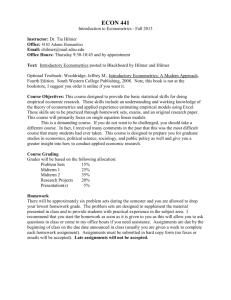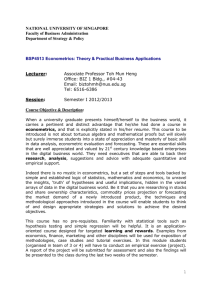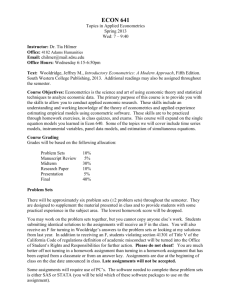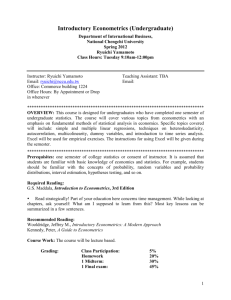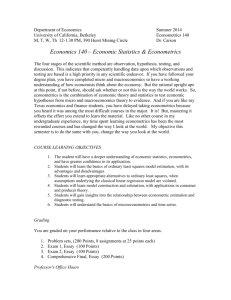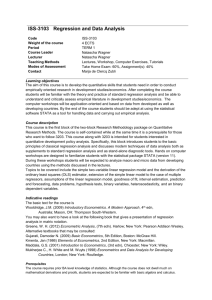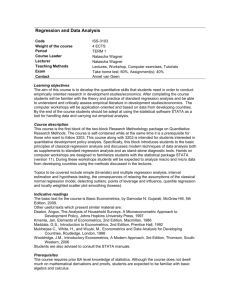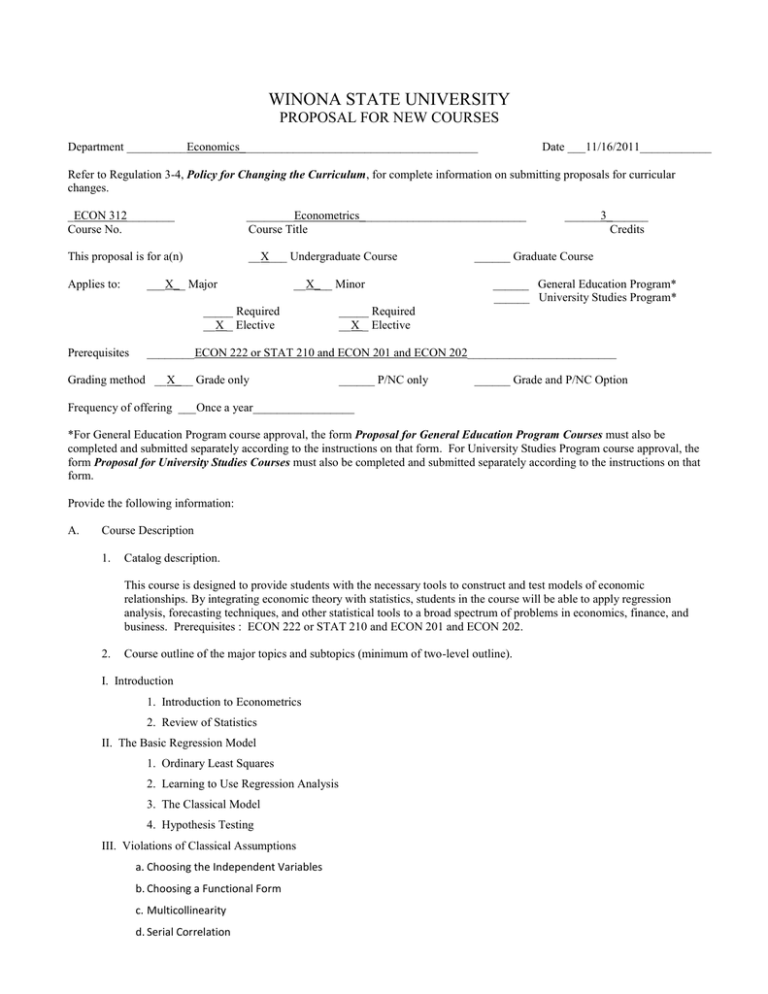
WINONA STATE UNIVERSITY
PROPOSAL FOR NEW COURSES
Department __________Economics________________________________________
Date ___11/16/2011____________
Refer to Regulation 3-4, Policy for Changing the Curriculum, for complete information on submitting proposals for curricular
changes.
_ECON 312________
Course No.
________Econometrics____________________________
Course Title
This proposal is for a(n)
__X___ Undergraduate Course
Applies to:
___X__ Major
__X___ Minor
_____ Required
__X _ Elective
Prerequisites
______3_______
Credits
______ Graduate Course
______ General Education Program*
______ University Studies Program*
_____ Required
__X _ Elective
________ECON 222 or STAT 210 and ECON 201 and ECON 202_________________________
Grading method __X___ Grade only
______ P/NC only
______ Grade and P/NC Option
Frequency of offering ___Once a year_________________
*For General Education Program course approval, the form Proposal for General Education Program Courses must also be
completed and submitted separately according to the instructions on that form. For University Studies Program course approval, the
form Proposal for University Studies Courses must also be completed and submitted separately according to the instructions on that
form.
Provide the following information:
A.
Course Description
1.
Catalog description.
This course is designed to provide students with the necessary tools to construct and test models of economic
relationships. By integrating economic theory with statistics, students in the course will be able to apply regression
analysis, forecasting techniques, and other statistical tools to a broad spectrum of problems in economics, finance, and
business. Prerequisites : ECON 222 or STAT 210 and ECON 201 and ECON 202.
2.
Course outline of the major topics and subtopics (minimum of two-level outline).
I. Introduction
1. Introduction to Econometrics
2. Review of Statistics
II. The Basic Regression Model
1. Ordinary Least Squares
2. Learning to Use Regression Analysis
3. The Classical Model
4. Hypothesis Testing
III. Violations of Classical Assumptions
a. Choosing the Independent Variables
b. Choosing a Functional Form
c. Multicollinearity
d. Serial Correlation
e. Hetroskedasticity
IV. Extensions of the Regression Model
a. Time Series Models
b. Dummy Dependent Variables
c. Simultaneous Equations
d. Forecasting
e. Experimental and Panel Data
V.
Applications of Econometrics
a. Economic models
b. Forecasting models
c. Finance models
d. Topics in Econometrics
i.
Estimating supply and demand elasticities
ii.
Models of demand determinants for a goods and services
iii.
Models of wage determination
iv.
Estimating the Capital Asset Pricing Model (CAPM) in finance
v.
Estimating the consumption funciton
vi.
The Keynesian model of aggregate expenditures
vii.
Estimating multipliers for monetary and fiscal policies
viii.
Forecasting exchange rates and interest rate
ix.
Estimating the Phillips curve
3.a Instructional delivery methods utilized: (Please check all that apply).
Lecture: Auditorium
ITV
Online
Lecture: Classroom X
Service Learning
Travel Study
Other: (Please indicate)
3.b. MnSCU Course media codes: (Please check all that apply).
None:
X
3. Internet
1. Satellite
4. ITV Sending
2. CD Rom
5. Broadcast TV
Web Enhanced
Laboratory
6. Independent Study
7. Taped
8. ITV Receiving
Web Supplemented
Internship/Practicum
9. Web Enhanced
10. Web Supplemented
4. Course requirements (papers, lab work, projects, etc.) and means of evaluation.
Weekly required assignments and three exams
5. Course materials (textbook(s), articles, etc.).
Text: Studenmund, A.H., Using Econometrics: A Practical Guide, 6th Edition, Pearson – Addison Wesley, 2011.
Wooldridge, J.M., Introductory Econometrics: A Modern Approach, 4th Edition, South Western, 2009.
Boehmer, E., Using SAS in Financial Research, Grin Verlag Publishing, 2002.
6. Assessment of Outcomes
At the end of this course students will know how to:
a.
Interpret regression results
Assessment: Assignments & Exams
b.
Perform regression analysis
Assessment: Assignments
c.
Critically analyze empirical work
Assessment: Assignments & Exams
d.
Know how to improve empirical work
Assessment: Assignments
e.
Understand the theoretical framework of regression analysis
Assessment: Exams
f.
Apply econometrics to economic models and relationships
Assessment: Assignment and Exams
7. List of references.
Kennedy, Peter, A Guide to Econometrics, 6th Edition, Blackwell, 2008.
Ajmani, Vivek, Applied Econometrics Using the SAS System, Wiley, 2009.
Brooks, C., Introductory Econometrics for Finance, 2nd Edition, Cambridge University Press, 2008.
B.
Rationale
1.
Statement of the major focus and objectives of the course.
To educate students about econometrics and its direct application to economic models and relationships in order to prepare
them for graduate school and for careers as economists or econometricians and to encourage them to be critical consumers of
statistics.
2.
Specify how this new course contributes to the departmental curriculum.
Econometrics, the integration of economic theory with statistical analysis, is a standard tool among economists. Students who
graduate with a degree in economics, whether they immediately enter the workforce or continue with graduate school, can
expect to apply econometric techniques and analysis in a variety of situations. As a course that applies econometric analysis to
many of the economic models and relationships included across the economics curriculum, this course will allow students to
further integrate their learning and will significantly enhance the preparation of economics majors.
3.
Indicate any course(s) which may be dropped if this course is approved.
None. The course is an elective and will be part of the cycle of offerings in the department.
C.
Impact of this Course on other Departments, Programs, Majors, or Minors
1.
2.
Does this course increase or decrease the total credits required by a major or minor of any other department? If so, which
department(s)? NO
Attach letter(s) of understanding from impacted department(s).
Definitions:
01-Satellite:
02- CD Rom:
03- Internet: Predominately = where all, or nearly all, course activity occurs in an online environment. One to two activities may
occur face-to-face in a classroom, with the maximum being two activities.
04 – ITV Sending: a course in which students are in the classroom with the instructor, other students join via interactive television
technology from other geographically separate locations
05 – Broadcast TV:
06 – Independent Study: a course in which the teacher develops specialized curriculum for the student(s) based on department
guidelines in the University course catalog
07 – Taped: a course in which the teacher records the lessons for playback at a later date
08 – ITV Receiving: a course in which students are not in the classroom with the teacher, other students join via interactive television
technology from other geographically separate locations
09 – Web Enhanced- Limited Seat Time: For a course in which students are geographically separate from the teacher and other
students for a majority of required activities. However, some on-site attendance is required. The course includes synchronous and/or
asynchronous instruction.
10 – Web Supplemented- No Reduced Seat Time: For a course utilizing the web for instructional activities. Use of this code may
assist your college/university in tracking courses for “smart classrooms” and/or facility usage.
Attach a Financial and Staffing Data Sheet.
Attach an Approval Form with appropriate signatures.
Department Contact Person for this Proposal:
___Marv Wolfmeyer______________
Name (please print)
____457-5182____________
Phone
___MWolfmeyer@winona.edu______
e-mail address
[Revised 9-7-11]
WINONA STATE UNIVERSITY
FINANCIAL AND STAFFING DATA SHEET
Course or Program___Economics____________________
Include a Financial and Staffing Data Sheet with any proposal for a new course, new program, or revised program.
Please answer the following questions completely. Provide supporting data.
1.
Would this course or program be taught with existing staff or with new or additional staff? If this course would be taught by
adjunct faculty, include a rationale.
This will be taught by existing staff. Two faculty members who teach statistics, formerly with the Business Administration
Department, are now with the Department of Economics. With changes in curriculum requirements in the College of Business that
have reduced the demand for ECON 322, one section per year of this new course can be readily taught by existing staff.
2.
What impact would approval of this course/program have on current course offerings? Please discuss number of sections of
current offerings, dropping of courses, etc.
The intent is to offer the course once per year. As mentioned above, changes in curriculum in the College of Business will allow the
Department of Economics to offer this course without out any effect on the rest of the program’s courses. One section of ECON 322
can be replaced with Econometrics without affecting our ability to meet student demand.
3.
What effect would approval of this course/program have on the department supplies? Include data to support expenditures for
staffing, equipment, supplies, instructional resources, etc.
We do not anticipate any effect. It will be taught in the same fashion as one of the statistics section it will replace.
[Revised 9-05]
WINONA STATE UNIVERSITY
NEW AND REVISED COURSE AND PROGRAM APPROVAL FORM
Routing form for new and revised courses and programs.
Course or Program__________________________________
Department Recommendation
_________________________________
Department Chair
________________
Date
Dean’s Recommendation _____ Yes
_________________________________
Dean of College
____________________________________________
e-mail address
_____ No*
________________
Date
*The dean shall forward their recommendation to the chair of the department, the chair of A2C2, and the Vice President for
Academic Affairs.
A2C2 Recommendation
_____ Approved
_____ Disapproved
_________________________________
Chair of A2C2
________________
Date
Graduate Council Recommendation
(if applicable)
_____ Approved
_________________________________
Chair of Graduate Council
________________
Date
_________________________________
Director of Graduate Studies
________________
Date
Faculty Senate Recommendation
_____ Approved
_________________________________
President of Faculty Senate
_____ Disapproved
_____ Disapproved
________________
Date
Academic Vice President Recommendation _____ Approved
________________________________
Academic Vice President
Decision of President
_____ Approved
_________________________________
President
_____ Disapproved
________________
Date
_____ Disapproved
________________
Date
Please forward to Registrar.
Registrar
_________________
Date entered
Please notify department chair via e-mail that curricular change has been recorded.
[Revised 9-1-10]

